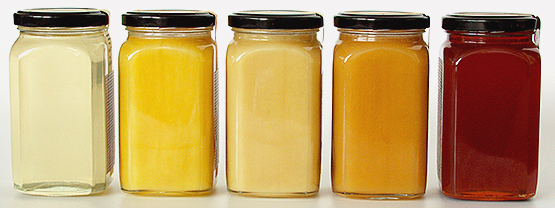The variety of nectar and honeydew influences the honey type. In spring we are harvesting the light colored floral honeys while the harvest in summertime is mainly darker honeydew based honey.
In Switzerland there are few unifloral honeys: rape, sweet chestnut, acacia, dandelion, rhododendron and Abies (fir or spruce). The advantage of marketing unifloral honeys is that consumers can chose honey with a definite odour and taste. Unifloral honey is an added value product. It can be seen as a fingerprint of its area of origin thus telling a story and carrying emotions.
HMF-Gehalt, Invertase- und Diastaseaktivität von in- und ausländischen Honigen - Analyse mit logistischer Regression (German) (PDF, 320 kB, 24.09.2016) HMF, Invertase and diastase activity of Swiss and imported honeys - Analysis with logistic regression
M. Gfeller, S. Bogdanov (2006)
Authentication of Botanical Origin of Honey (PDF, 1 MB, 14.09.2016)
K. Ruoff (2006)
Classification of honeydew and blossom honeys by discriminant analyses (PDF, 142 kB, 14.09.2016)
S. Bogdanov, M. Gfeller (2006)
Potential of Near Infrared Spectroscopy for Authenticity Testing of Unifloral Honey (PDF, 221 kB, 14.09.2016)
K. Ruoff, W. Luginbühl, S. Bogdanov, J-O. Bosset, V. Kilchenmann, B. Estermann, Th. Ziolko, S. Kheradmandan, R. Amadò (2003)
Classification of unifloral honeys with an MS-based electronic nose using different sampling modes: SHS, SPME and INDEX
(The document is available at www.springerlink.com)
S. Ampuero, S. Bogdanov, J.-O. Bosset (2004)






